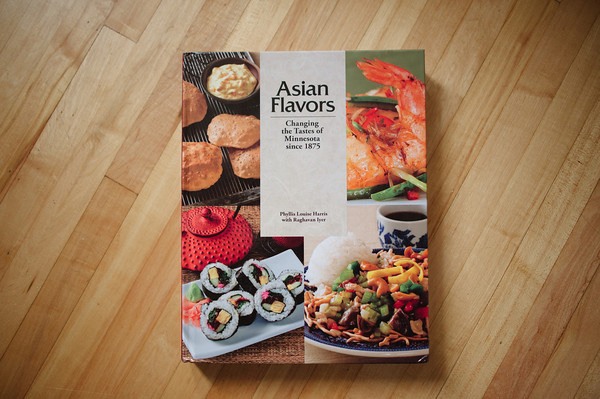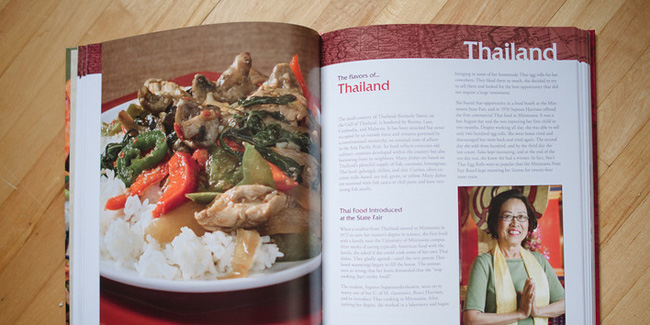
There’s much to like about Asian Flavors: Changing the Tastes of Minnesota since 1875 ($34.95, 247 pages, Minnesota Historical Society Press). It’s an ambitious new book that tackles the history and current state of Asian and Asian-influenced dining in the Twin Cities and (to a lesser extent) Minnesota in general. Author Phyllis Louise Harris takes a country-by-country approach as she documents Chinese, Japanese, Vietnamese, and other Asian nations’ contributions to the local culinary melting pot, using interviews, essays, and recipes to tell the stories of many of the area’s landmark eateries.
If you’d ever wondered about the pioneers of Asian food in Minnesota, this book is a bountiful font of dates and biographies, and the knowledgeable essays from contributing author and Indian culinary expert Raghavan Iyer are as luminously educational as you might expect. Recipes stud its pages, largely offering simplified versions of foundational Asian dishes (bulgogi, spring rolls, momos) that spring easily to the mind of the casual diner, and ample color photographs light up its pages.
But the book’s introduction foreshadows trouble: It bookends the state’s first Chinese restaurant (Canton Restaurant, opened in 1883) with the current local flagship of vibrant, creative Asian flavor: Thom Pham’s Wondrous Azian Kitchen.

Thus, Asian Flavors is a sweet-and-sour mix of fascinating historical digging (Minnesota’s pheasant population was imported from China between 1916-1918!) and earnest stumbling through the modern scene (the words “banh mi” don’t appear anywhere in the Vietnam section, but you can apparently get a good submarine sandwich over at Quang).
If you’re curious about any of the bedrock historical Asian restaurants, they’re here — the origin stories of Leeann Chin, Fuji Ya, Nanking, Sawatdee Thai, Mai Village, and numerous other landmarks are told at length and in a friendly, professional tone that only occasionally strays into Chamber of Commerce territory. If Asian Flavors had cast itself as a work focused on early history, it would have been an straightforward hit, full of foundational memories and lovingly recounted life stories.
But instead of a committed history book, we get a thematic see-saw — between a mastery of the past and a bewilderment by the present that is magnified by an apparent fear on the part of the author of offending someone, somewhere, anywhere. Asian Flavors often fails to differentiate between notoriety and quality; the book dwells at length on restaurants with shaky or downright flabby culinary reputations while inexplicably skipping over a raft of significant players: Masu Sushi & Robata, True Thai, and Ngon are absent, and local landmarks like Rainbow Chinese and Origami are mentioned only in passing. And largely missing from this book are stories of conflict, prejudice, struggles to source ingredients, compromise and frustration, and even broken dreams — which is to say the emotional (and financial!) heart of the restaurant business.
 On the positive side of the scales, the geographic scope of Asian Flavors (both in Minnesota and in Asia) is both broad and evenly distributed, with surprising cameos from lands such as Mongolia and Singapore. Ethnic markets make frequent appearances, and the family connections that are the beating heart of so many local restaurants are very much on display throughout the book’s pages. On balance, it’s a book that is a useful addition to any local food enthusiast’s library, and a sound way to map out the bedrock foundation of Asian food in Minnesota. But for learning the modern lay of the land, a recent copy of the Star Tribune will serve the reader more faithfully.
On the positive side of the scales, the geographic scope of Asian Flavors (both in Minnesota and in Asia) is both broad and evenly distributed, with surprising cameos from lands such as Mongolia and Singapore. Ethnic markets make frequent appearances, and the family connections that are the beating heart of so many local restaurants are very much on display throughout the book’s pages. On balance, it’s a book that is a useful addition to any local food enthusiast’s library, and a sound way to map out the bedrock foundation of Asian food in Minnesota. But for learning the modern lay of the land, a recent copy of the Star Tribune will serve the reader more faithfully.


“…notoriety and quality” That’s a whole book topic by itself! As always your balanced view adds credibility to your reviews! Thanks for sharing, looks interesting.
-Jade